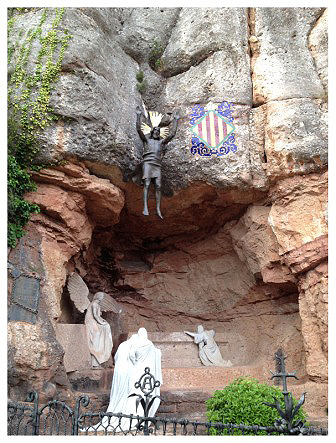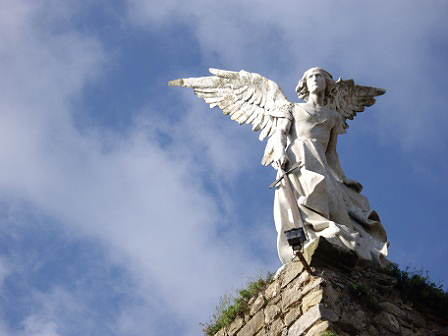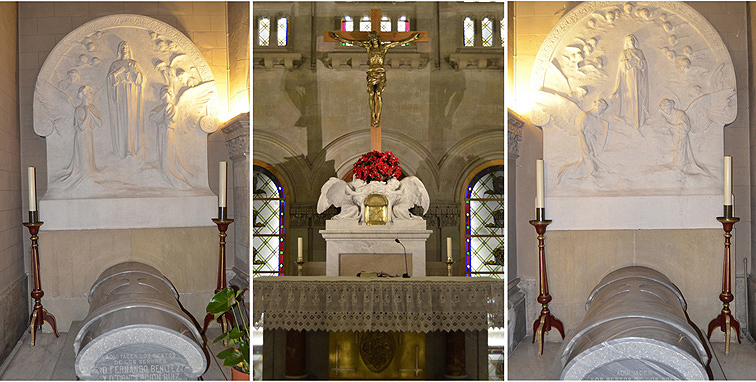Piece of the month of October 2013
THE WORK OF JOSEP DE LLIMONA I BRUGUERA AT THE NAVARRA HOSPITAL
Jorge Latorre Izquierdo
Chair of Navarrese Heritage and Art
Pamplona is proud of its recumbent Christ by Agapito Vallmitjana, which is carried in procession on Good Fridays on the beautiful Art Deco-style platforms designed by Víctor Eusa. However, no attention has ever been paid to the religious work produced for the chapel of the Hospital de Navarra by the best disciple of the Valmitjana workshop in Barcelona, Josep Llimona i Bruguera (1864-1964), who is much better known in the history of Spanish art than his master. In fact, this famous Catalan sculptor symbolises the transition between academicism and modernity, directly influenced by Rodin, and is an example of quality religious art at the crossroads of the fin-de-siècle.
He played a leading role in Catalan Modernisme, as he founded with his brother the painter Joan Llimona the Sant Lluc Artistic Centre, to which Gaudí belonged, and with whom, between 1903 and 1916, he designed the Risen Christ of the First Mystery of Glory of the Monumental Rosary of Montserrat. In 1907 he was awarded the award of Honour by the exhibition International Fine Arts Museum of Barcelona for his well-known sculpture Desconsol (Disconsolation), which can be seen in the Parque de la Ciudadela in Barcelona and in the Prado Museum in Madrid. He was also highly praised in Paris, Brussels and Buenos Aires. In Spain he produced splendid urban monuments, including the Doctor Robert in Barcelona, and received numerous funerary commissions, including those for the Comillas cemetery and Barcelona Cathedral.

Josep Llimona i Bruguera, Christ Resurrected
First Mystery of Glory of the Monumental Rosary of Montserrat

Josep Llimona i Bruguera, The exterminating angel
Cemetery of Comillas (Cantabria)
However, neither the programs of study on art in Navarre nor the general bibliography on Llimona make accredited specialization to this set of the tabernacle and Christ crucified with angels, and the two large funerary reliefs that accompany it, which is why I think it is worth devoting a commentary to it in this section on artistic jewels of Navarrese art. It was commissioned by the founder of the Hospital de Navarra, Dñª. Concepción Benítez Ruiz, who decided to use her Mexican husband's inheritance for this charitable work, commissioned at the beginning of the 20th century to the architect Enrique Epalza, advised by the doctor Antonio Simonena. The project was very ambitious - twenty-nine buildings arranged in three rows with pavilions, chapel and living quarters for the staff- but it was carried out at a slow pace and with very poor economic management management assistant , which seriously damaged the donor's finances and forced fail the works in 1911, when only six pavilions and the historicist chapel had been built. The sculptural complex must therefore have been built between 1906 and this date, since on 24 December 1912, the founder gave the Pamplona City Council - the Provincial Council rejected the offer - the land in the Soto de Barañain with the express accredited specialization that "the right of burial for her late husband and for her tomorrow" (1) would be respected.
The tombs of the founder and her husband are arranged at the foot of the main altar, on the floor of the central nave, while on the sides are the tombs of her descendants, for which two large bas-reliefs serve as altarpieces, in symmetry both in terms of composition and material. The one on the Epistle side is dedicated to the Assumption of Mary, and the one on the Gospel side to the Ascension of Christ, whose face sample bears a close resemblance to the bust of the Saviour made by Constantin Meunier in 1900. In these two reliefs, angels stand on the ground in awe and adoration, while small Italian-style putti fly triumphantly around the glorious bodies as they rise to Heaven.

Josep Llimona, High altar and tombs of the Ruiz Benítez family
Chapel of the Hospital de Navarra
It is a sculpture subject that follows 19th century pre-Raphaelite models. Closer to Rodin's innovative work are the two angels who protect the tabernacle with their arms and hide their faces in perpetual adoration before the Eucharist. Above these angels rises a gilded bronze Crucified Christ, from the academicist invoice , which completes the white marble ensemble with a grade of colour and luminosity to match the tabernacle. The grey marble of the side tombs also contrasts with the vaporous white of the reliefs. Although this work does not have the force of other religious themes by Llimona (the Risen Christ of Montserrat or the Angel Watcher in the cemetery of Comillas, for example), it is an example of sacred art worthy of admiration, at a time when the loss of religious artistic taste was occurring on a large scale (together with the commercialisation of cheap industrial figures for private and public worship), as the convert writer K. H. Huysmans denounced in his book "The Religious Art of the Church", in which he wrote about the loss of religious artistic taste. H. Huysmans in his work Les foules de Lourdes (1906).

Josep Llimona, Tabernacle and relief of the Assumption
Chapel of the Hospital of Navarre
In contrast to these "realist" forms, which are a hedonistic degradation of the classical concept of beauty according to the most banal and sentimental aspects of popular culture, quality contemporary sacred art would be inclined towards an "ugly" primitivism (defending authenticity against beauty, with the consequent expressionist drift) or towards abstract experimentation, which prevent religious contemplation by a public uninitiated in avant-garde art. But Llimona still maintains a balanced tradition between artistic quality and popular piety, and for this reason - and also because of the undeserved neglect of his work in Pamplona - I thought it appropriate to select this group from the Hospital chapel as an example of a religious art that was a pioneer in the Pamplona of its time and, having overcome the old dichotomies of the historical avant-garde, is increasingly valued in our own city as well.
NOTES
(1) Cf. On the vicissitudes of the Hospital of Navarre, see "Cien años de la capilla". And also the classic, by Marcelo Núñez de Cepeda, La beneficencia en Navarra a través de los siglos, Escuelas Profesionales Salesianas, Pamplona, 1940.
